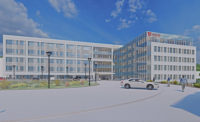In the foothills above Salt Lake City, a surge in construction activity at the state's largest university is creating much-needed space for students and faculty. In 2009, University of Utah officials unveiled a new master plan and launched an ambitious capital building program that has completed more than $300 million in projects in the last few years.

Overall, the university will build just over $1.1 billion worth of new projects, $780 million of which are currently under way, with another $45 million recently approved.
Key projects under construction include the $46.7-million expansion of the university's Neuropsychiatric Institute, the $102-million James LeVoy Sorenson Molecular Biotechnology building and the $155-million Utah Science & Technology Research Initiative building, among others.
Revenue Generators
Despite the poor economy and a tight state budget, projects on campus have moved forward, with 80% of new construction and renovations financed through traditional bonding, university-generated revenue and private donations, says Michael Perez, associate vice president for facilities management. “As a university, we are fortunate to have some facilities that generate revenue,” he says.
The university operates a major hospital and health-care network in the Salt Lake Valley as well as the Moran Eye Center—a specialty eye care hospital—and the Huntsman Cancer Institute, which drives money back into university coffers.
“The research we do here has also resulted in many start-up businesses,” says Perez. “They make money that goes to the university before they go public or are purchased by other companies. We've also been fortunate to have some very generous donors who have really been the bread and butter for some of these projects.”
University officials say the surge of new projects is driven by pent-up demand, aging facilities and a new vision for the 31,000-student campus.
“We have had modest growth in enrollment and growth in the last 10 years in research and graduate studies, but there has been a lot of compression on campus for a while and people doubled up in offices and cubicles,” says Perez. “We have to compete with other institutions for researchers, and we need space for them.”
Core Campus
John McNary, director of campus design and construction, says the new master plan outlines a different type of construction for the 1,534-acre campus located two miles east of downtown.
“At one time, the vision was for the campus to be more like a business park,” he says. “Buildings were spread out with parking lots in between, and students would drive or walk to classes.” The new plan calls for creating a campus less reliant on cars. “We want a better core campus, more centered and vibrant,” McNary adds.
Traditionally, the bulk of students have come from the surrounding Wasatch Front metropolitan area, with fewer students living on campus. But a rising demand for more on-campus housing is being addressed with new construction, such as the $31-million Honors Housing at Legacy Bridge project.
| Utah Science & Technology Research Initiative Building James LeVoy Sorenson Molecular Biotechnology Building | 155.0 |
| Huntsman Cancer Hospital Expansion | 102.0 |
| Ambulatory Care Complex | 100.0 |
| Utah Museum of Natural History | 97.0 |
| David Eccles School of Business | 68.0 |
| L.S. Skaggs Pharmacy Institute | 66.0 |
| University Neuropsychiatric Institute Expansion | 46.7 |
| Student Life Center | 42.0 |
| Honors Housing at Legacy Bridge | 31.0 |
| Sorenson Arts & Education Building | 24.0 |
| Critical Infrastructure Distribution Replacement & HPER Mall Restoration | 19.8 |
| Thatcher Building for Biological and Biophysical Chemistry | 17.0 |
| University Guest House Expansion | 10.0 |
The Utah Transit Authority's TRAX light rail has four stops on campus, and new TRAX lines will soon connect it with western segments of the Salt Lake Valley so that more students can access the campus without a car.
“We want to make this less of a commuter campus and more of a place where students will come and stay, leave their cars at home and engage on campus for a better academic experience,” says McNary.
Underground pipes that deliver high-pressure steam and hot water across campus are more than 30 years old and have exceeded their expected life span. A major section of steam pipes and electrical lines running through the center of campus was excavated in the past year.
The utility lines were replaced and enclosed in a concrete maintenance tunnel rather than reburied. But much more replacement and upgrading is needed to meet the anticipated demands, McNary adds.
“We spent about $30 million (on the new lines and tunnel), but we need about $99 million more to complete the upgrades across campus,” he says. The university sought the funds from the Utah Legislature in the last session, but the request was denied.
McNary says the bulk of the recent projects have been delivered through construction management/general contractor contracts. “It is a more convivial process than the standard design-build relationship, where we ran into problems managing outside consultants,” says McNary. “Now those consultants usually team with local firms, and it works well for us.”
McNary says CM/GC has allowed the university to complete more work on weekends and holidays when fewer students are on campus and there is less impact on patients at its health-care facilities. “At places like the Huntsman Cancer Hospital, we need a short time frame, because when those facilities are closed, it costs us money,” he says.
The school's next major project will be finding an off-campus location to consolidate its various specialty clinics. “That was recently approved and will be about a $25-million project,” McNary says.
Article toolbar

Post a comment to this article
Report Abusive Comment